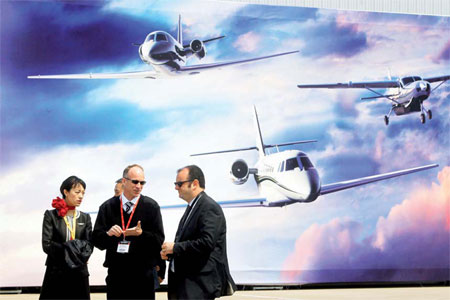Cleared for take-off
Updated: 2012-12-21 08:40
By Meng Jing (China Daily)
|
||||||||
|
Visitors at the Asian Business Aviation Conference and Exhibition held in Shanghai earlier this year. China is expected to have 2,000 general-aviation aircraft by 2015 and the number may rise to 10,000 by 2020. Yong Kai / for China Daily |
The auto industry in China employs approximately 40 million people, and if the general aviation industry is to take off it will have its work cut out to provide the labor and skills needed. However, there is a gaping hole at the moment, and that is providing huge opportunities to those who can offer pilot training, product support and maintenance and more.
"There are not enough pilots," says Jackson of Genesis Investment, which began to look at investing in general aviation since last year. "Call any flight training school in the US and they will probably tell you there are some Chinese pilots training there. It is even difficult to find catering companies for business jets in China. If you want to have food you need to call those commercial airlines for help."
Garrison of Bell Helicopter says the rapidly increasing demand for helicopters in China will require thousands of professionals to fly and maintain these aircraft.
"There is not only an opportunity to help create these jobs, but also ensure China has access to the best operational and technical training possible."
Although he says he is not satisfied with Bell's market share in China, the company is clearly optimistic about its future in the country, having signed a memorandum of understanding with Guangzhou Civil Aviation College to build Bell's first maintenance training facility in the country.
Bell says it will be authorized to conduct maintenance and repair training for two Bell helicopter models. Eventually it could expand to give maintenance training on other models.
"We are planning for the future," Garrison says. "If you assume you will grow, it is better to be ahead than behind."
The world's leading business-jet maker, Gulfstream of the US, is also moving to strengthen its position in China by adding more Chinese personnel to its Beijing service center, which opened last month.
"It is our first center in the Chinese mainland," says Roger Sperry, a regional senior vice-president with Gulfstream. "With this center it will be more cost effective for our customers in China to have services in the mainland rather than going to Hong Kong or Singapore."
Sperry says that with demand for Gulfstream's business jets gradually shifting from North America to Asia and Latin America, more support staff are needed.
"China is one of the major driving forces for our new orders."
Last year 102 Gulfstream jets were stationed in China, he says; 10 years earlier there were none.
The company has already added about 1,400 staff this year, including those at its Beijing service center, and in a department in Hong Kong it also opened this year. How many of those recruits are locals is unclear.
Some aircraft makers have gone further to set up local production, creating more high-tech jobs in China. Diamond Aircraft of Austria, a single-engine plane maker, has had a joint venture in China since 2005.
"Having a local production base in China is an advantage as we can reach markets we couldn't access before," says Gernot Brabner, executive general manager of Binao-Diamond Aircraft of Shandong.
"We've even considered increasing our capacity from 60 aircraft to 100 a year from next year."
Cessna Aircraft signed agreements this year to join the government of Chengdu, in Sichuan province, and the state-owned Aviation Industry Corp of China in a joint venture to produce mid-sized business jets and possibly other new models in the future.
Many more joint ventures are expected to mushroom in China, in a similar path that the auto industry took, experts say.
For Bingham, of Piaggio Aero, the lack of infrastructure, such as airports, and the shortage of personnel, including pilots, hold challenges for the industry in the short term.
"But the Chinese government has committed so much to developing this sector, and they have realized that they are way behind on aviation. General aviation is going to develop in the typical Chinese way. After being the last, they intend to be the first."
mengjing@chinadaily.com.cn
(China Daily 12/21/2012 page1)

 Relief reaches isolated village
Relief reaches isolated village
 Rainfall poses new threats to quake-hit region
Rainfall poses new threats to quake-hit region
 Funerals begin for Boston bombing victims
Funerals begin for Boston bombing victims
 Quake takeaway from China's Air Force
Quake takeaway from China's Air Force
 Obama celebrates young inventors at science fair
Obama celebrates young inventors at science fair
 Earth Day marked around the world
Earth Day marked around the world
 Volunteer team helping students find sense of normalcy
Volunteer team helping students find sense of normalcy
 Ethnic groups quick to join rescue efforts
Ethnic groups quick to join rescue efforts
Most Viewed
Editor's Picks

|

|

|

|

|

|
Today's Top News
Chinese fleet drives out Japan's boats from Diaoyu
Health new priority for quake zone
Inspired by Guan, more Chinese pick up golf
Russia criticizes US reports on human rights
China, ROK criticize visits to shrine
Sino-US shared interests emphasized
China 'aims to share its dream with world'
Chinese president appoints 5 new ambassadors
US Weekly

|

|







